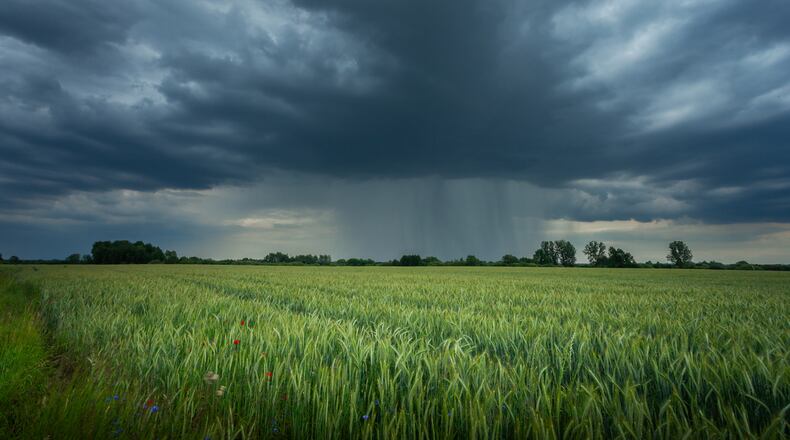- Sir Thomas Browne
Phases of the Thin Time Moon
Nov. 1: The Thin Time Moon is new.
Nov. 9: The moon enters its second quarter.
Nov. 15: The moon is full.
Nov. 22: The moon enters its final quarter.
Weather Trends
The 15th, 19th and 20th are the days this week most likely to be mild with highs in the 60′s. The fifth cold front of the month comes through at the end of the period, and the 21st brings a slight possibility for a high only in the 20′s. The 15th is the day most likely to bring precipitation, having a 60 percent chance of rain or snow. The 20th is also fairly damp, carrying a 50 percent chance. The 18th is the driest day of the week; it has only a 20 percent chance of showers or flurries.
The Natural Calendar
Privets are holding on, their leaves a yellow gray-green. Sugar gums sport a few red remnants. Leaves of the decorative Bradford pear are dark brown, ready to come down in a heavy frost. Osage fruits cover the ground.
Moss has new sprouts, a promise of March on old logs. Winter wheat grows taller, creating wide patches of emerald green in the gray landscape. The grasses along the freeways have turned pale. Fields of goldenrod heads glow in the sun, more exotic than when they were in flower. Box elder seeds shimmer. Burdock burs are poised, waiting for you to brush against them.
Colors deepen too in the swamp. Protected by the water, cress shines; dock and ragwort grow back beside the dead field grasses.
Christmas cactus has begun to blossom. Paperwhites, set in moist soil or in pebbles with water, send up their foliage.
Red fruits stand out on the flowering crabapple trees and on the hawthorns, on the honeysuckles and on the bayberries.
Skunk cabbage has already pushed to the surface, and it is ready to bloom in a warm December
In the Field and Garden
Grazing ordinarily comes to a close in Midwestern pastures as the ground temperature approaches 40 degrees. Strawberries can now be mulched with straw. Fertilize trees after their leaves have fallen. Schedule your frost-seeding for January and February. Deep water all perennials before the ground freezes, especially if your garden suffered from the drought this summer.
Clean up all around the yard and garden, cut your wood, clear out the hedgerows and haul manure. Plant next year’s sweet peas for early April sprouting
Test the soil of the field, pasture and garden, adding the correct nutrients for late autumn and early spring growth.
Finish repairs to the outbuildings. Plant an evergreen in the yard. Now that the leaves are down, you will be able to position it for best winter appearance.
Fertilize pastures for improved winter hardiness and stimulation of growth in early spring.
Journal
Counting absences
Days without red-winged blackbirds
- Autumn Samadhi
The inventory of middle autumn at the end of October is rich in foliage and color, but the settling in of late autumn in November draws down the density and texture of the canopy and strips away almost all the floral barriers to winter. As spring overcomes February and March with an accumulation of new growth, fall spreads across the summer with an accumulation of loss.
One enumeration of late fall is the counting of what no longer holds, a counting of emptiness, cued only by memory and the more durable, woody scaffolding that binds the seasons:
Foliage of apple trees and crab apple trees, ginkgoes, sugar maples, trees of heaven, redbuds, black walnuts, catalpas, box elders, locusts, elms, birches, poplars, cottonwoods, peach trees, cherry trees, Osage, red oaks, white oaks, chinquapin oaks sycamores, red mulberries, sweet gums, silver maples, Japanese maples, white mulberry trees, beeches, magnolias, mock orange and silver olive shrubs, honeysuckles, Korean lilacs, quinces, privets, viburnums, burning bush, dogwoods, spireas, standard lilacs, down or collapsing.
Silent mornings: no more robins chattering, no cardinal song, no dove song, no red-winged blackbird song, no grackle song, no cicada song, no katydid song, no cricket song.
Hollow milkweed pods, bare raspberry canes, bare blackberry canes, the leaves of hostas and stonecrop melted, innumerable flowers absent, and harvest complete. No wheat, soybeans, corn, tomatoes, peas, beans, cucumbers, zucchini, lettuce.
Bill Felker lives with his wife in Yellow Springs. His “Poor Will’s Almanack” airs on his weekly NPR radio segment on WYSO-FM (91.3).
About the Author
